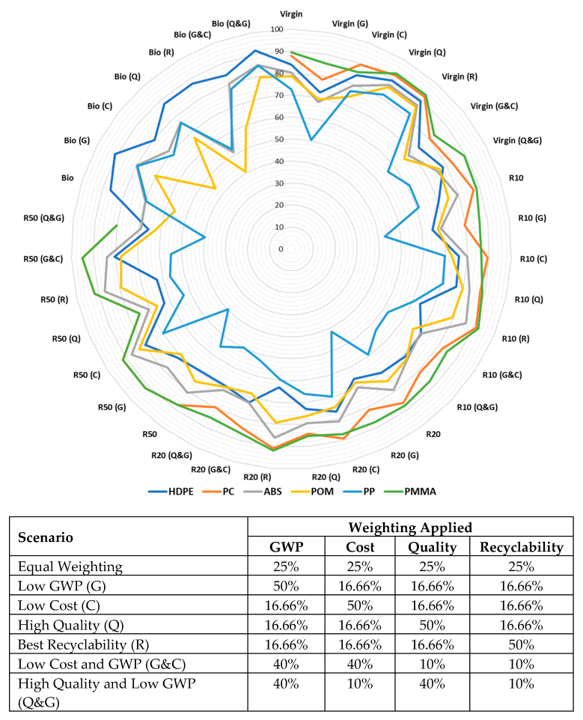Japan has an issue with plastic. The country is the second highest producer of plastic waste per capita, owing in part to an excess of packaging.
 Multicriteria assessment of virgin, recycled and bioplastics for six different plastic types considering cost, emissions, perceived quality, and recyclability. The higher the points, the greater the desirability of the plastic to manufacturers. Image Credit: Gustavo Kyushu University
Multicriteria assessment of virgin, recycled and bioplastics for six different plastic types considering cost, emissions, perceived quality, and recyclability. The higher the points, the greater the desirability of the plastic to manufacturers. Image Credit: Gustavo Kyushu University
Even though plastic pollution is a well-known problem, the role that plastics play in global warming is frequently ignored. Surprisingly, the plastics industry is a significant contributor to carbon emissions, accounting for 4.5% of all emissions worldwide.
Currently, Yokohama-based start-up business Sotas Co., Ltd. and Kyushu University have conducted a collaborative study to examine the possibilities for the Japanese market to adopt a greener plastic supply chain.
The Japanese government has pledged to achieve carbon neutrality by 2050. However, the predominant method that Japan uses to get rid of plastic waste is ‘thermal recycling’ or incineration, which releases carbon dioxide into the atmosphere. We have examined whether switching to more sustainable recycled plastics and bioplastics is a competitive and effective alternative to current carbon reduction policies.
Andrew Chapman, Study Senior Author and Professor, International Institute for Carbon Neutral Energy and Research, Kyushu University
The researchers began by assessing the economic and environmental impact of six frequently used plastic types based on whether they were created from virgin, recycled, or bioplastic. They graded the plastics based on four factors: global warming potential, cost, recyclability, and perceived quality by manufacturers. The researchers estimated the appeal of each plastic was in a variety of circumstances based on the weighting given to each element.
In general, the researchers discovered that while virgin plastics are regarded to have the finest quality, they have a large global warming potential and are somewhat pricey.
Recycled plastics, on the other hand, are less expensive and have a reduced risk for global warming. Plastics with a larger recycled content, however, were regarded to be of lesser quality, and recyclability differed widely amongst plastic types.
One issue is that it can be physically harder to separate out some types of plastics before recycling and additionally, some plastics can only be recycled a certain number of times. It is therefore important to establish a robust, centralized chain of custody to keep track of how many times a piece of plastic has been recycled to provide quality assurance to end users.
Yuuki Yoshimoto, Study First Author and President, Sotas Co., Ltd.
The study also discovered that bioplastics, which are manufactured from plants, had the lowest potential for global warming. Some bioplastics can even be carbon-negative since plants absorb carbon dioxide from the environment as they develop, which is then stored in the material.
However, bioplastics are far more expensive to produce than virgin or recycled plastics. Because drop-in replacements are not always accessible, they currently score poorly in terms of perceived quality. Furthermore, starch-based bioplastics necessitate the cultivation of crops.
Chapman added, “Food versus plastic production is not a fight we want, as land resources are very limited in Japan.”
Instead, the researchers proposed more funding for research into cellulose-based bioplastics produced from wood pulp.
The consumers’ willingness to pay is an additional aspect that could aid in closing the cost gap between virgin plastics and bioplastics. Consumers can be prepared to pay extra for ecologically friendly items, according to prior studies, which the researchers want to thoroughly examine and take into account in their study.
Yoshimoto concluded, “This is a complex situation, with no one-size-fits-all solution. Ultimately, we hope this analysis can help policymakers decide what recycling processes to support, and to inform manufacturers which plastics can best meet their manufacturing and carbon reduction goals.”
This study broadens the range of potential policy directions that decision-makers might take by taking into account the economic effectiveness of carbon reduction through plastic recycling and bioplastic substitution.
Journal Reference:
Yoshimoto, Y., et al. (2023) Toward Economically Efficient Carbon Reduction: Contrasting Greening Plastic Supply Chains with Alternative Energy Policy Approaches. Sustainability. doi:10.3390/su151713229